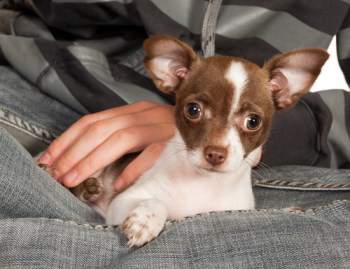Health (General & Serious)
Chihuahua Health
Overview
Compared to other dog breeds, the Chihuahua is a relatively healthy breed with few serious health problems.
With this said, it is important to be aware of what constitutes good health and to know the signs and symptoms of possible health conditions.
Some genetic heath conditions can be triggered by overexertion during play or exercise and others can be caused by not following proper care guidelines.
In this section we will go over all health facts, offer excellent care tips and discuss the details of Chihuahua health problems that affect puppies, adult and seniors.
Common Signs of Illness
While there are countless symptoms that can present for various medical issues and injuries, ahead is a helpful Daily Check List that can be used to access a Chihuahua's basic health level.
Temperature:
The normal body temperature of canines is between 101 and 102 degrees F (38.33 to 38.88 C). Therefore, a temperature higher than this is reason for concern and should be brought to the attention of the veterinarian.
Eyes:
The color and condition of the eyes can signal health changes. Bright, clear eyes are a sign of good health. For many Chihuahua puppies and dogs, a slight watery discharge is normal (and should be wiped away 1 or 2 times per day to keep tear staining
at bay) however the following points to a possible health concern: thick discharge, excessive discharge, discoloration of the sclera (the white part of the eye) and/or cloudiness.
Nose:
A nose does not need to be cool and moist. For most dogs, the nose will vary between being cool and warm and change from being moist to dry over the course of a day. However, the following is not normal: Discharge, crusting and/or cracking.
Ears:
There are a few health concerns for this breed in regard to the ears. It is not uncommon for a Chi to have at least one bacterial or yeast ear infection in his lifetime. Mites are also a concern. Excessive wax buildup can also become troubling if the ears are not cleansed. Signs of issues are: Odor, excessive wax, discharge and/or itching ( the dog will paw at his ears or attempt to rub them up against a surface such as a wall or carpeting)
Breathing: Raspy, labored breathing is a sign of a medical issue (more ahead in Chihuahua Health Concerns). In addition, bad breath can also point to an issue, often with a tooth/mouth infection.
Chihuahua Health Care Tips
Here are some important, routine caring elements to keep Chihuahua puppy and dogs happy and healthy:
1. Wait until puppy shots are complete before taking your puppy into public.
Some owners just can't wait to show off their Chihuahua, bringing the puppy to stores when buying supplies, etc.
While other shoppers rush over to see the cute little puppy, those who know better cringe at such a sight! Puppies should not be brought to any public places until they have received all of their puppy shots.


To do so puts the pup at great risk. Just to be safe, many veterinarians recommend to wait 2 weeks after vaccinations are complete to ensure that the last round is protecting the Chihuahua. There will be plenty of time to show off your Chi when the puppy's immune system is protected.
2. Spread out meals throughout the day. While many different dog breeds can rather quickly be moved from 3 meals per day to two and then to one, this does not hold true for most Chihuahuas.
There are two reasons why:
1)
This breed has a very fast metabolism
2)
Being so small, a Chihuahua is only able to eat small amounts of food at one sitting.
Due to these elements, calories are burned off quickly. To keep a Chi from experiencing revolving levels of energy and high and low blood sugar levels, it is never recommended to go below two meals per day.
Be sure to offer lots of healthy snacks as well, raw baby carrots is a favorite that is low in calories and packed with vitamins.
3.Protect your Chihuahua from temperature fluctuation. Be aware of possible temperature changes. This breed does not do well with fast drops or rises in temperatures. After a bath, have a warm soft towel right at hand to prevent chills. On icy cold days, protect your Chihuahua with clothing and boots or paw wax. Use the AC to keep the house cool on hot summer days and when outside in the heat take breaks in the shade, offering water while your Chihuahua rests.
4. Offer daily exercise.
Today's world can be a busy one. Most people work all day and then go home to more work: housecleaning, cooking, etc. It can be easy for an owner to put off taking their dog for a walk. "He's small, he got plenty of exercise just running around the house" is a common excuse.
For canines, eating a well-balanced, wholesome means and having regular exercise are 2 of the most important elements to maintaining good health. In the overall scheme of things, taking 20 to 30 minutes to offer a brisk walk will not throw off the day that much but will be very beneficial for a Chihuahua of any age.
5. Stay on schedule with at-home dental cleanings. Cleaning and brushing a Chihuahua's teeth is a vital part of health care for this breed. Vulnerable to tooth problems, routine brushings help to keep tarter and plaque at bay. Once a year professional cleanings are recommended as well. For owners who don't offer this, all too late infections are noticed and they turn rather serious medical issues. Infection can enter the blood stream, there can be permanent tooth loss and more.
Common Health Issues with the Chihuahua Breed
The Chihuahua is prone to certain breed-specific health conditions. Owners should be aware of possible health risks, since some can be prevented and others, when found early enough, can respond very well to treatment.
Luxating Patella
Overview - This is a condition in which the knee cap slips out of its place. Sometimes, it is not severe enough to need surgical treatment and sometimes it is. Your vet will tell you what steps to take. Genetics can make a Chihuahua prone to this and then a certain action - such as running or jumping down from a certain height - can trigger it.
Ethical breeders should have any potential breeding dogs checked for this and if found, that dog should be eliminated from the breeding program.
One tricky element about this condition is that a dog may only feel pain when the kneecap initially slips out of place. Some continue to walk normally for several hours afterward. Swelling will begin to inflame the area and it is at that time that most Chihuahuas will show signs that something is wrong.
Signs - The most common symptoms of this are:
- Limping
- Favoring one side of the body
- Reluctance to run
- Whimpering when jumping from sofa to floor, etc.
- Yelping out when being picked up
Diagnosis - X-rays will confirm is the patella has slipped out of place; though some veterinarians are able to know simply by manipulating the leg.
Treatment - Bed rest is often a key element to healing. The dog should be crated or enclosed in a small gated area where he will not be able to walk or jump up. During this time. anti-inflammatory medication is given to help with both the pain and the swelling. With proper rest, this can heal well though most dogs will be prone for another episode. Running and jumping should be limited. Only in severe cases is surgery needed.
Collapsed Trachea
Overview - This is another health problem that is thought to be genetic, though injury can trigger it or cause it to happen even if this does not exist in a Chihuahua's family history. The windpipe is constructed of rings of cartilage. This health problem refers to when one or more of those rings collapse inward.
One of the main causes of collapsed trachea with the Chihuahua is when an owner uses a collar and not a harness. When on leash with a collar alone, all force of any tension is directly applied to the dog's neck.
Alternatively, with the proper harness, tension is distributed over the dog's shoulders, back and chest. This is an important part of preventing terrible condition.
Symptoms- The signs of this are usually very obvious with very few minor cases and many more moderate to severe cases. Signs include:
- Difficulty breathing - breathing may be raspy or loud
- Coughing - A Chihuahua may have a honking or hacking sort of cough. With some, it may sound as if the puppy or dog is attempting to cough up a hair ball. Others describe this a the sound of a goose.
- Trouble eating or drinking - In some, but not all cases, a dog may have trouble swallowing
Symptoms may worsen when the dog is excited or when the weather is hot and humid.


Diagnosis- The distinctive honking cough is sometimes all that is needed to diagnose this, though it will be confirmed with x-rays.
Treatment - Approximately 70% of Chihuahuas will recover from this with non-surgical treatment if all guidelines are followed.
1)
A combination of medication will be given, including:
Cough suppressants
Bronchodilators
Corticosteroids
2) Owners will be immediately instructed to cease connecting a leash to the collar. For this breed, the collar is only for ID purposes. A harness is the only appropriate accessory when on leash.
3)
If there is no improvement within 3 weeks and if discomfort is severe, surgery is the next course of action. Approximately 80% of surgical treatments for collapsed trachea are considered successful.
Hypoglycemia
Overview -
Just about all toy sized dogs are prone to this. Hypoglycemia refers to a rapid and dangerous drop in blood sugar levels. Newborns and puppies under the age of 4 months old are more vulnerable to this; though a Chihuahua of any age may develop it. It is particularly rampant with smaller than standard sized Chihuahua, sometimes referred to as Miniatures or Teacup Chihuahuas.
Symptoms -
The most common signs of this include:
- Weakness
- Dizziness
- Disorientation (the puppy may walk into a wall, etc.)
- Trembling
- Vomiting
Treatment -
It is imperative to treat this at home before transporting the puppy to an emergency medical facility. This is because without immediate treatment, a pup may fall into a coma. An owner can rub a fingertip's worth of honey directly onto the puppy's gums, allowing the natural sugars to quickly reach the bloodstream.
Once the dog is brought to the veterinarian or animal hospital, vital signs will be taken. Most Chihuahuas will need IV treatment to stabilize sugar levels.
Tooth Infection
Overview -
The Chihuahua breed is very prone to dental problems, including decay and infection. Therefore, without proper prevention and care, tooth loss is common. In regard to infection, there is always the risk that this will travel up to the sinuses or throughout the entire body, reaching vital organs such as the heart and brain.
Signs -
Decay will cause:
- Chronic bad breath issues
- Trouble eating
- Weight loss
- Pain and discomfort
- Possible infection that spreads to other areas of the body including the lungs and/or heart.
At-home brushings and professional scrapings will play an important role in keeping a Chihuahua healthy. Read more: Chihuahua Dental Care.
Dry Eye - kerato-conjunctivitis sicca (kcs)
Overview - Due to the shape and positioning of a Chihuahua's eyes, this breed is prone to eye problems with dry eye being the most common. This refers to the condition in which tear ducts fail to produce adequate lubrication. It usually affects adults and Senior Chihuahua more often than puppies; though it can develop in a dog of any age.
Signs - The most common symptoms of this are:
- Red, irritated eyes
- Rapid blinking
- Pawing at the eye
- Discharge - yellow or green
- Crusting of discharge around the eyes, most often noted when the Chihuahua first wakes up
- Vision trouble
Diagnosis- A thorough eye examination will be done. This should include:
- A sample of discharge to test to bacterial growth
- Schirmer test - This measures the amount of natural tears that are being produced.
- Fluorescein stain test - By using a safe dye that is dropped into the eye, a veterinarian can look for any possible ulcerations or abrasions.
Treatment - This is usually treated with:
- Special instructions to clean the eyes - usually twice per day
- Artificial tear drops
- Topical antibiotic
- Topical corticosteroid
In addition, the puppy or dog should be monitored for possible future ulcerations that may develop.
You may also be interested in:
Chihuahua hernias
- The Chihuahua is predisposed to inguinal hernias and umbilical hernias are the most common type seen with canines. Learn about signs, diagnosis, treatment, and care.
At home pain medication for Chihuahuas
- Out of the leading OTC pain meds that you may have at home, (Advil, Aleve, Tylenol, etc.) learn which ones you can give to a Chihuahua for pain or fever and proper dosing.
Chihuahua coughing - Covers wheezing, odd hacking noises, and both acute and chronic coughing. Top reasons and red flags.
Chihuahua Puppy Vaccinations - The typically vaccination schedule to expect. Also possible side effects and reactions.
Chihuahua hair loss - For moderately to severe thinning coats; top reasons for hair loss. Steps you can take at home to try and promote hair growth.
How to fix Chihuahua bad breath - Top reasons why a Chi may have stinky breath, red flags, and exactly how to cure this from home.
Chihuahua skin care - Covers dry skin issues and how to prevent and treat common issues.
Are raw food diets good for Chihuahuas - Weighing both the pros and cons.
Are you a PetChiDog Member Yet?
When you become a free Member of the site, you'll be able to receive a friendly alert when a new page of information has been added. You will also be able to suggest a topic for us to write about (we always look to Member suggestions).
It's quick, free & keeps you in the loop!
We are a participant in the Amazon Services LLC Associates Program, an affiliate advertising program designed to provide a means for us to earn fees by linking to Amazon.com and affiliated sites.
Email: Contact@PetChiDog.com



